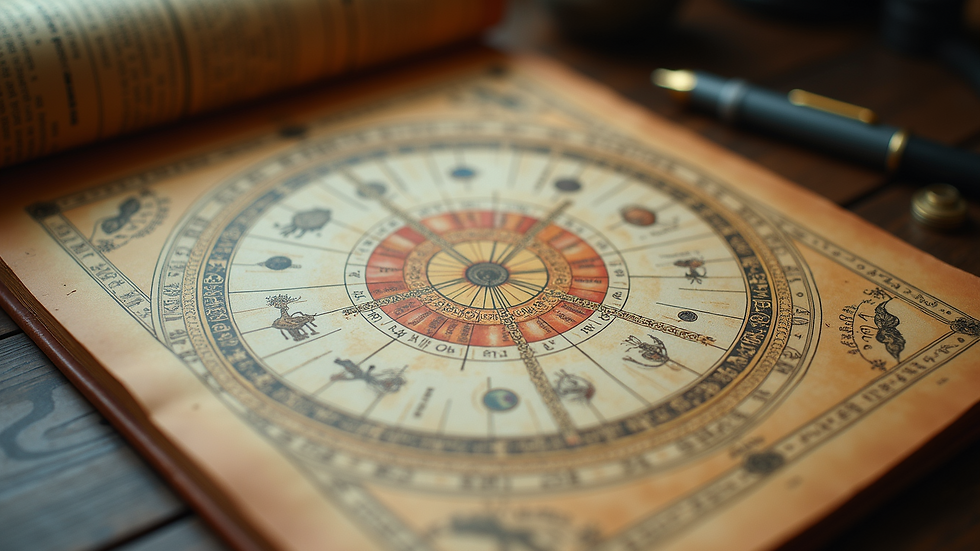Mastering the Basics of Vedic Astrology
- Atish Jain
- Sep 18
- 4 min read
Have you ever wondered how the stars and planets might influence your life? Vedic astrology offers a fascinating way to explore this connection. It’s an ancient system that helps us understand ourselves and the world around us through the movements of celestial bodies. Let’s dive into the basics together and see how this timeless wisdom can be both practical and inspiring.
Understanding Vedic Astrology Fundamentals
Vedic astrology, also known as Jyotish, is a traditional Indian system that dates back thousands of years. Unlike Western astrology, which uses the tropical zodiac, Vedic astrology relies on the sidereal zodiac. This means it considers the actual positions of the stars and constellations in the sky.
At its core, Vedic astrology is about timing and cycles. It helps us identify auspicious moments for important events, understand personality traits, and even predict challenges and opportunities. The system uses a detailed chart called a kundli or birth chart, which maps the positions of planets at the exact time and place of your birth.
Here are some key components to get familiar with:
Planets (Grahas): There are nine main planets in Vedic astrology, including the Sun, Moon, Mars, Mercury, Jupiter, Venus, Saturn, and two shadow planets, Rahu and Ketu.
Zodiac Signs (Rashis): The twelve signs represent different energies and characteristics.
Houses (Bhavas): The birth chart is divided into twelve houses, each representing different areas of life such as career, relationships, and health.
Nakshatras: These are 27 lunar mansions or star clusters that add another layer of detail to the chart.
By understanding these elements, we can start to see how Vedic astrology offers a rich, nuanced view of life’s patterns.

How Do I Know My Vedic Zodiac?
One of the first questions many people ask is, “How do I know my Vedic zodiac sign?” This is a great place to start because your zodiac sign in Vedic astrology might be different from what you expect if you’re familiar with Western astrology.
Your Vedic zodiac sign is determined by the position of the Moon at the time of your birth, not the Sun. This is why it’s often called the Moon sign. To find it, you need your exact birth date, time, and place. With this information, you can generate your birth chart using online tools or consult an expert.
Here’s a simple way to get started:
Gather your birth details: Date, time, and place of birth.
Use a reliable Vedic astrology calculator: Some websites offer free birth chart generation.
Identify your Moon sign: This is your Vedic zodiac sign and reveals your emotional nature and inner self.
Knowing your Vedic zodiac sign opens the door to deeper self-awareness. It helps you understand your natural tendencies, strengths, and areas for growth.

The Role of Planets and Houses in Your Life
Once you know your Vedic zodiac, the next step is to explore how planets and houses influence your life. Each planet has a unique energy and governs specific aspects of your personality and experiences.
For example:
Sun: Represents your soul, ego, and vitality.
Moon: Governs emotions, mind, and intuition.
Mars: Symbolizes courage, energy, and action.
Jupiter: Associated with wisdom, growth, and prosperity.
The twelve houses in your birth chart correspond to different life areas:
Self and personality
Wealth and possessions
Communication and siblings
Home and family
Creativity and children
Health and service
Partnerships and marriage
Transformation and inheritance
Higher learning and spirituality
10. Career and reputation
11. Friendships and gains
12. Losses and liberation
Planets placed in these houses influence how you experience these life areas. For instance, if Jupiter is in your 10th house, it might indicate success and growth in your career.
Understanding this interplay helps you make informed decisions and align your actions with your natural strengths.

Practical Tips to Apply Vedic Astrology in Daily Life
You might be wondering, “How can I use this knowledge practically?” The beauty of Vedic astrology is that it’s not just theoretical. It offers actionable insights that can guide your daily choices.
Here are some ways to apply it:
Choose auspicious timings: Use Vedic astrology to pick the best dates for important events like weddings, business launches, or travel.
Understand relationship dynamics: Knowing your and your partner’s charts can improve communication and harmony.
Plan career moves: Identify periods of growth or caution based on planetary transits.
Enhance personal growth: Work on areas highlighted by your chart, such as patience, confidence, or creativity.
Use remedies: Vedic astrology suggests simple remedies like wearing specific gemstones, chanting mantras, or performing rituals to balance planetary influences.
Remember, astrology is a tool for empowerment, not fear. It helps you navigate life with awareness and confidence.
Embracing the Journey of Vedic Astrology
Mastering the basics of Vedic astrology is a rewarding journey. It connects us to ancient wisdom while offering practical guidance for modern life. As you explore your chart and the cosmic energies at play, you’ll find new ways to understand yourself and the world.
Let’s embrace this journey with an open heart and mind. The stars have stories to tell, and by listening, we can shine brighter in our own lives. Ready to explore your cosmic blueprint? The universe is waiting.
Feel free to share your experiences or questions about Vedic astrology in the comments below. We’re all learning together!
.png)




Comments